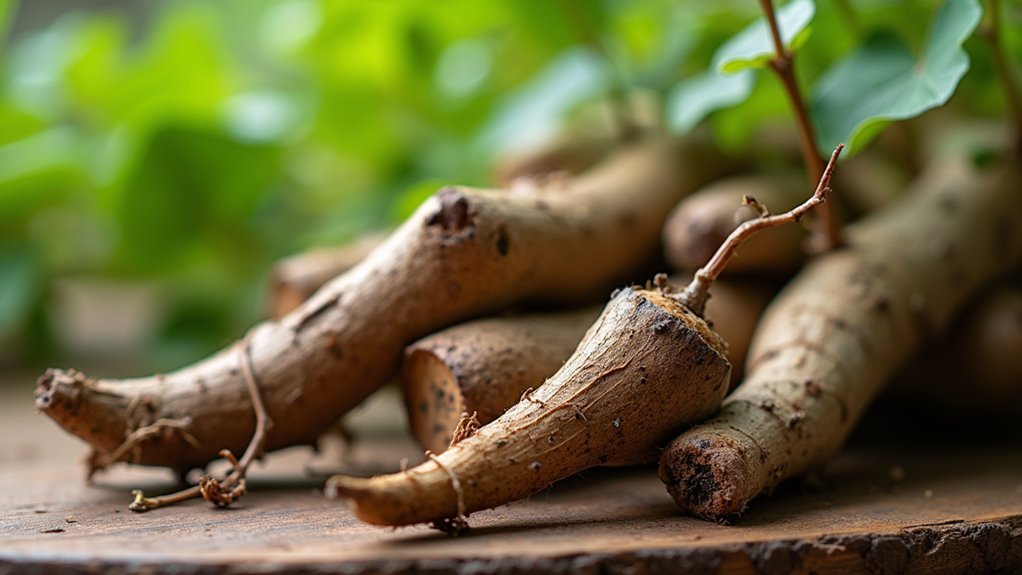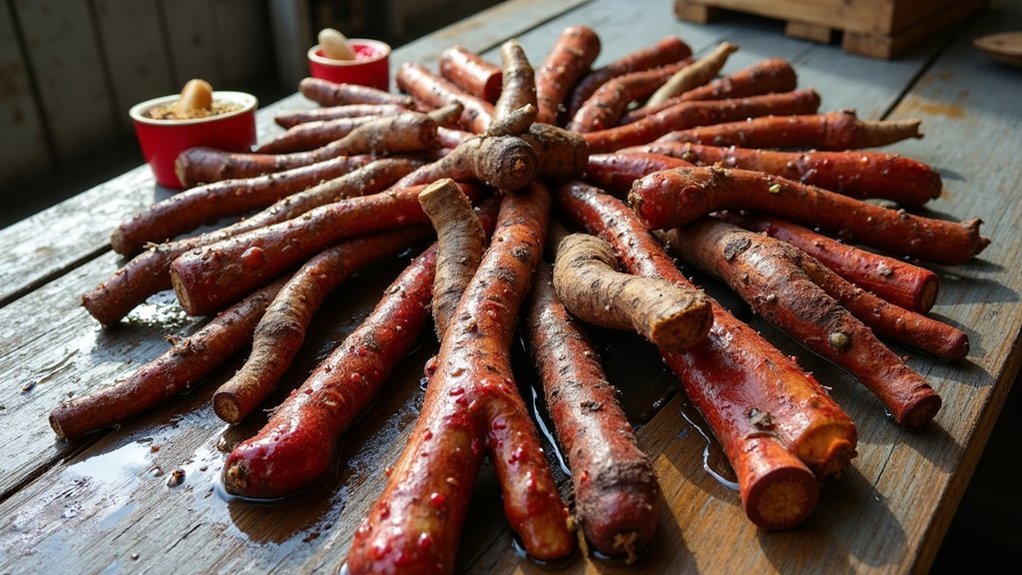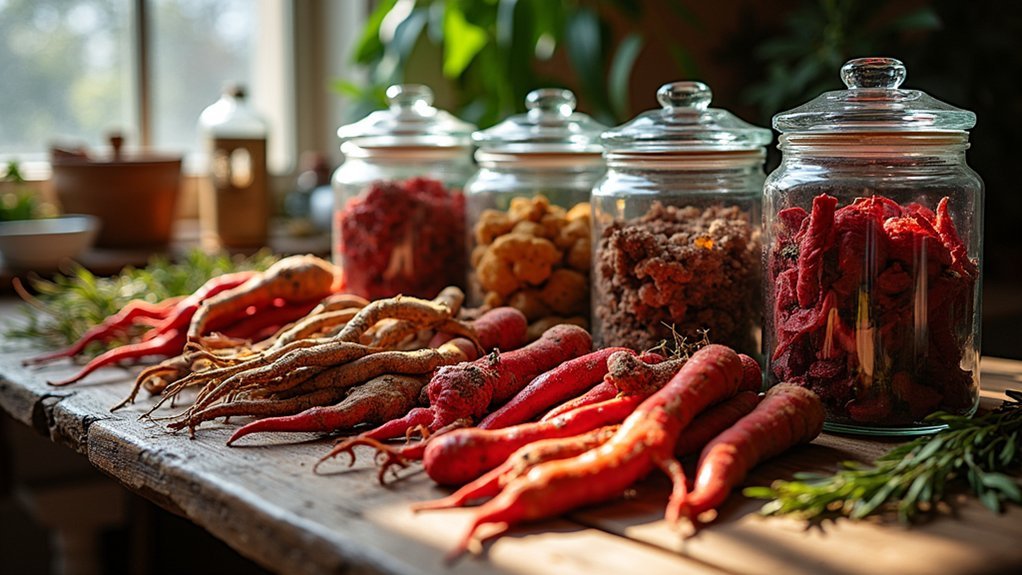To clean wild city roots, first rinse them thoroughly in a plastic tote, then gently scrub with a soft brush. Soak in a 1:3 vinegar solution for 10-15 minutes to kill pathogens. Dry using low heat or direct sunlight, turning frequently. Store fully dried roots in airtight containers with silica gel packets in cool, dark places around 60°F. For best results, harvest wild garlic in late spring and Florida Betony in spring or fall. The following guide reveals more essential foraging techniques.
Identifying Safe Urban Root Varieties for Foraging

While many city dwellers overlook the edible treasures growing beneath their feet, urban environments often host a variety of forageable roots that can supplement your diet with unique flavors and nutrients.
When searching for wild food, focus on readily identifiable species like wild garlic (Allium canadense) and Florida Betony (Stachys floridana), which commonly grow in lawns and backyards.
You'll recognize wild garlic by its hollow, tube-like stems and distinctive onion aroma—a vital identification feature that helps distinguish it from toxic look-alikes such as daffodil shoots and death camas.
Florida Betony produces edible tubers resembling grubs that can be harvested in spring and fall. These mild-flavored roots adapt well to various recipes.
Always research local conditions before foraging, as urban pollution and chemical treatments may affect your harvest's safety.
Essential Tools and Materials for Root Processing
Three essential tools form the foundation of any urban root forager's kit: a sturdy garden spade for excavating roots without damage, protective gloves that shield your hands from potential irritants, and a deep plastic tote for thorough cleaning.
The urban forager's trinity: sturdy spade, protective gloves, and deep cleaning tote—essential companions for responsible root harvesting.
You'll also need brushes or cloths to gently remove dirt without compromising the root's surface integrity.
For drying, arrange tin sheets in direct sunlight to eliminate moisture completely—this critical step prevents spoilage during storage.
Once dried, transfer your roots to sealed containers that maintain consistent moisture levels and protect against environmental changes.
Store these containers at approximately 60°F (15°C) for ideal preservation.
With these essential tools and proper temperature control, your foraged roots can maintain their quality and usefulness for up to three years.
Thorough Cleaning Methods to Remove Urban Contaminants

You'll need to assess your urban-foraged roots for potential soil contaminants before beginning the cleaning process.
Start with a multi-stage washing technique, including an initial rinse, gentle scrubbing with a soft brush, and a vinegar solution soak to effectively remove city toxins.
This thorough cleaning protocol guarantees you've eliminated harmful substances like pesticides, heavy metals, and industrial pollutants that commonly affect wild roots in urban environments.
Soil Contaminant Assessment
Once you've collected wild roots from urban environments, proper cleaning becomes essential to remove potential contaminants. Before processing, visually assess your wild finds for signs of harmful soil exposure, like unusual discoloration or residue.
Begin by washing roots thoroughly in a plastic tote filled with water, making certain all soil particles are dislodged. Use a soft brush to gently scrub crevices where contaminants often hide.
After initial cleaning, soak the roots in a diluted vinegar solution (1:3 vinegar-to-water ratio) for 10-15 minutes to kill remaining pathogens. Rinse again under clean running water to remove vinegar residue.
This soil contaminant assessment process helps guarantee you're not consuming harmful substances that may have accumulated in urban growing environments. Allow roots to dry completely in a shaded area before storing in sealed containers.
Multi-Stage Washing Techniques
Thoroughly cleaning urban-foraged roots requires a systematic multi-stage washing process to effectively eliminate contaminants that simple rinsing can't remove.
Begin by placing your roots in a plastic tote with clean water to dislodge surface debris.
Next, use a soft brush or cloth to gently scrub each root, focusing on crevices where dirt often hides.
Follow with a secondary rinse under running water to wash away all loosened contaminants.
For an extra safety measure, soak your roots in a diluted vinegar solution for 10-15 minutes to kill potential bacteria or pathogens. This step is particularly important when cleaning roots from urban environments where pollutants are common.
Finally, thoroughly dry the roots with a clean towel or air-dry them in a well-ventilated space to prevent moisture-related decay during storage.
Urban Toxin Removal
While multi-stage washing provides a solid foundation for cleanliness, urban roots often harbor more insidious contaminants that require specialized techniques.
After your initial scrub with a vegetable brush to remove surface dirt and pesticides, implement targeted urban toxin removal methods.
Create a solution of 1 part vinegar to 3 parts water and soak your foraged roots for 10-15 minutes. This acidic bath helps disinfect and neutralize many common urban pollutants that washing alone can't address.
Once soaking is complete, rinse the roots thoroughly with clean water to eliminate any vinegar residue that might affect flavor.
Complete the process by air-drying your roots in a cool, well-ventilated space before storage. This vital step prevents moisture-related spoilage and guarantees your wild city treasures remain safe for consumption.
Effective Drying Techniques for Long-Term Preservation

After you've collected your wild city roots, proper drying becomes the critical next step for successful preservation.
Begin by thoroughly washing the roots to remove all dirt—this prevents contamination that could ruin your dried leaves and roots later.
For effective dehydration, choose a low-heat method:
- Use an oven at its lowest setting (typically 150-170°F)
- Place roots in direct sunlight on a dry, clean surface
- Turn roots frequently to guarantee even drying and prevent mold
Once completely dry, store your roots in sealed containers at room temperature.
This simple storage technique helps maintain quality and extends shelf life to approximately three years.
Remember that cool, consistent conditions are key to preventing moisture fluctuations that would compromise your carefully preserved specimens.
Proper Storage Solutions to Maintain Root Quality
You'll need climate-controlled options that maintain consistent temperatures to preserve your wild roots for years.
Invest in quality containers that seal completely, preventing moisture intrusion that quickly leads to spoilage.
Proper moisture prevention techniques, like adding silica gel packets or natural desiccants, can further protect your botanical treasures during long-term storage.
Climate-Controlled Storage Options
Once your wild city roots are thoroughly cleaned and dried, proper storage becomes vital for preserving their quality and extending their usable lifespan.
The ideal climate-controlled storage environment maintains a consistent temperature around 60°F (15°C), protecting your botanical treasures from degradation.
To maximize root longevity up to three years:
- Use sealed containers that prevent moisture fluctuations while maintaining proper airflow
- Place storage containers in a cool, dark area away from direct sunlight and heat sources
- Check your stored roots monthly for any signs of moisture or mold development
Remember that temperature consistency is important for maintaining potency.
If you don't have access to specialized climate-controlled storage, a cool basement or closet away from temperature fluctuations can serve as an effective alternative.
Regular inspection guarantees your wild root collection remains viable throughout its storage period.
Moisture Prevention Techniques
Beyond climate control, effective moisture prevention forms the backbone of any successful wild city root storage system.
You'll need to thoroughly dry your roots before storing them, as lingering dampness invites spoilage and quality degradation.
Seal your root treasures in airtight containers to block environmental moisture fluctuations.
Consider adding desiccants or moisture-absorbing materials inside your containers for additional protection—silica gel packets work wonderfully for this purpose.
Develop a habit of regularly inspecting your stored roots for any signs of moisture or mold.
If you spot affected specimens, remove them immediately to prevent contamination of your entire collection.
With proper moisture prevention techniques, your wild roots can maintain their quality for up to three years, ensuring you'll have ample time to use your urban foraging finds.
Containers Worth Investing
Three essential container types stand out for preserving your wild city root discoveries. When selecting containers worth investing in, prioritize those that provide an airtight seal to maintain consistent moisture levels.
Glass jars, food-grade plastic containers, and specialized herb storage vessels offer the best protection for your collected roots.
- Glass mason jars with rubber gasket seals create an impermeable barrier against humidity while allowing you to monitor your roots visually.
- Food-grade plastic containers with snap-lock lids provide lightweight, durable storage that's less prone to breakage.
- Vacuum-sealed containers offer premium protection by removing all air that could accelerate degradation.
Remember to thoroughly dry your roots before storage and maintain a consistent temperature around 60°F (15°C).
With proper containers, you'll extend preservation time up to three years while protecting against mold and quality loss.
Seasonal Harvesting Calendar for City Root Foragers
To maximize both flavor and nutritional content of your urban wild root finds, you'll need to align your foraging activities with nature's calendar. Timing is everything when it comes to seasonal harvesting of wild roots.
Mark your calendar for wild garlic collection between late spring and early summer, when its energy peaks. Florida Betony roots are best unearthed during spring and fall, avoiding summer's intense heat.
Remember that many valuable roots like dogbane can vanish entirely during temperature extremes. Pay attention to your local climate patterns, as urban microclimates can affect growth cycles.
Once you've harvested, clean and process your roots promptly to prevent spoilage. The effort of following nature's rhythms rewards you with superior flavor and nutrition from your foraged treasures.
Frequently Asked Questions
What Are the Best Wild Edibles in Missouri?
You'll find Missouri's best wild edibles include flavorful ramps in spring, custardy pawpaws in late summer, prized morel mushrooms, nutritious acorns (after leaching), and summer berries like blackberries and elderberries for sweet treats.
What Roots Are Edible in the Wild?
You'll find many edible wild roots including wild garlic, Florida Betony, and dogbane. Each offers unique flavors, but you must identify them carefully as some look similar to toxic plants. Always clean thoroughly before consuming.
What Roots Can You Eat Raw?
You can eat several wild roots raw, including wild garlic, dandelion, Florida Betony tubers, and chufa. They'll offer unique flavors from pungent to bitter, but always carefully identify them first to avoid toxic look-alikes.
In Summary
You're now equipped to safely forage, process, and preserve urban root finds. By following proper identification, cleaning, drying, and storage practices, you'll enjoy these nutritious treasures year-round. Remember, timing is everything—consult your seasonal calendar before heading out. With these skills, you've transformed concrete jungles into sustainable pantry resources. Happy foraging, and don't forget to harvest responsibly in your urban environment.





Leave a Reply